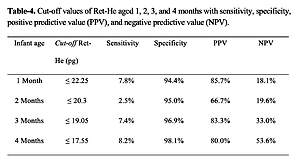Current issue
Archive
Manuscripts accepted
About the Journal
Editorial office
Editorial board
Section Editors
Abstracting and indexing
Subscription
Contact
Ethical standards and procedures
Most read articles
Instructions for authors
Article Processing Charge (APC)
Regulations of paying article processing charge (APC)
CLINICAL RESEARCH
Reticulocyte hemoglobin equivalent as a diagnostic parameter of iron deficiency anemia in infants age 1–4 months
1
Department of Child Health, Faculty of Medicine, Lambung Mangkurat University – RSD Idaman Banjarbaru, Banjarbaru, South Kalimantan, Indonesia
2
Department of Child Health, Faculty of Medicine, Lambung Mangkurat University- Ulin General Hospital, Banjarmasin, South Kalimantan, Indonesia
3
Reproductive Health-Maternal and Child Health-Family Planning, Faculty of Medicine, Lambung Mangkurat University, South Kalimantan, Indonesia
Submission date: 2022-03-18
Final revision date: 2022-06-30
Acceptance date: 2022-07-22
Online publication date: 2022-07-25
Corresponding author
Harapan Parlindungan Ringoringo
Department of Child Health, Faculty of Medicine, Lambung Mangkurat University – RSD Idaman Banjarbaru, Banjarbaru, South Kalimantan, Indonesia, BANJARBARU, Indonesia
Department of Child Health, Faculty of Medicine, Lambung Mangkurat University – RSD Idaman Banjarbaru, Banjarbaru, South Kalimantan, Indonesia, BANJARBARU, Indonesia
KEYWORDS
TOPICS
ABSTRACT
Introduction:
Iron deficiency anemia (IDA) is still a major global health problem. The prevalence was reported to be highest among children under five years, 39.7%, with the primary contributing cause being dietary iron deficiency (ID). Reticulocyte hemoglobin equivalent (Ret-He) assesses the amount of hemoglobin in reticulocytes. Ret-He is an easy, inexpensive, and applicable diagnostic parameter of iron deficiency. This study aims to determine the role of Ret-He as a diagnostic parameter of ID and IDA in infants 1–4 months old.
Material and methods:
The study was conducted prospectively at 10 Community Health Centers in Banjarbaru, South Kalimantan, from August 2020 to August 2021. In total, 403 infants aged 1, 2, 3, and 4 months met the inclusion and exclusion criteria. Venous blood samples were checked for Ret-He, complete blood count, and peripheral blood smears.
Results:
The incidence of ID and IDA in infants 1–4 months was 10.9% and 58.6%. Ret-He cut-off values for iron deficiency and IDA at 1, 2, 3 and 4 months were 22.25 pg, 20.3 pg, 19.05 pg and 17.55 pg, with sensitivity 7.8%, 2.5%, 7.4%, 8.2%, specificity 94.4%, 95.0%, 96.9%, 98.1%, positive predictive value 85.7%, 66.7%, 83.3%, 80.0%, and negative predictive value 18.1%, 19.6%, 33.0%, 53.6%.
Conclusions:
Ret-He can detect iron deficiency and IDA in a 1–4-month-old baby with high specificity and positive predictive value.
Iron deficiency anemia (IDA) is still a major global health problem. The prevalence was reported to be highest among children under five years, 39.7%, with the primary contributing cause being dietary iron deficiency (ID). Reticulocyte hemoglobin equivalent (Ret-He) assesses the amount of hemoglobin in reticulocytes. Ret-He is an easy, inexpensive, and applicable diagnostic parameter of iron deficiency. This study aims to determine the role of Ret-He as a diagnostic parameter of ID and IDA in infants 1–4 months old.
Material and methods:
The study was conducted prospectively at 10 Community Health Centers in Banjarbaru, South Kalimantan, from August 2020 to August 2021. In total, 403 infants aged 1, 2, 3, and 4 months met the inclusion and exclusion criteria. Venous blood samples were checked for Ret-He, complete blood count, and peripheral blood smears.
Results:
The incidence of ID and IDA in infants 1–4 months was 10.9% and 58.6%. Ret-He cut-off values for iron deficiency and IDA at 1, 2, 3 and 4 months were 22.25 pg, 20.3 pg, 19.05 pg and 17.55 pg, with sensitivity 7.8%, 2.5%, 7.4%, 8.2%, specificity 94.4%, 95.0%, 96.9%, 98.1%, positive predictive value 85.7%, 66.7%, 83.3%, 80.0%, and negative predictive value 18.1%, 19.6%, 33.0%, 53.6%.
Conclusions:
Ret-He can detect iron deficiency and IDA in a 1–4-month-old baby with high specificity and positive predictive value.
Share
RELATED ARTICLE
We process personal data collected when visiting the website. The function of obtaining information about users and their behavior is carried out by voluntarily entered information in forms and saving cookies in end devices. Data, including cookies, are used to provide services, improve the user experience and to analyze the traffic in accordance with the Privacy policy. Data are also collected and processed by Google Analytics tool (more).
You can change cookies settings in your browser. Restricted use of cookies in the browser configuration may affect some functionalities of the website.
You can change cookies settings in your browser. Restricted use of cookies in the browser configuration may affect some functionalities of the website.



